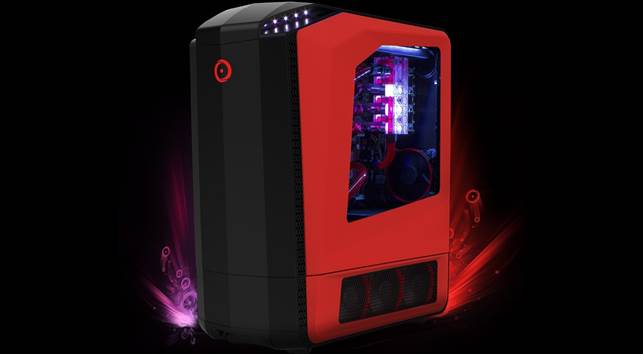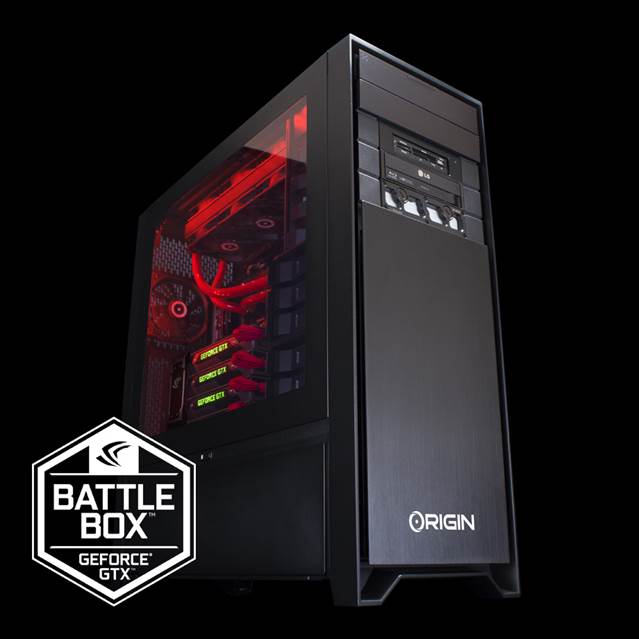Considering Australia is such a relatively
small market, we’re rather lucky to have so many boutique performance PC
builders. One of the most respected is Origin, a company renowned for ignoring
fiscal concerns in the quest to build the ultimate gaming powerhouse. It’s
recently released one of the most impressive builds we’ve seen in the Bunker
since HAL9000 tried to take over our game reviews area, in the form of the
Battlebox Millennium. Built in cooperation with NVIDIA’s Battlebox program,
this is one seriously meaty piece of gaming muscle.
The Battlebox program is being overseen by
NVIDIA, who has cherry picked the world’s custom-PC creators. To be considered
a Battlebox, the PC must have at least two graphics cards at least equal to the
NVIDIA GeForce GTX 780, paired with an overclocked Intel i5 or i7 CPU. NVIDIA
claims that this stupidly fast combination of hardware will deliver playable
performance at 4K resolution. Irrespective of whether these machines can indeed
make the 4K resolution their bitch, they’re guaranteed to run every PC game
known to humanity at Ultra detail settings, with a resolution of 2560 x 1600 or
below. The other unique feature of these machines is a custom-made SLI bridge
that will only be sold with Battlebox machines, but it’s actually just a normal
SLI bridge made to look fancy.

Our
Origin Battlebox arrived in a wooden shipping crate the size of a small fridge.
Our Origin Battlebox arrived in a wooden
shipping crate the size of a small fridge. Unpacking it revealed a beautifully
customized version of Corsair’s popular Obsidian 900D case, which towers over
700mm in height, while reaching a whopping 650mm deep. This voluminous case is
necessary for the oodles of hardware packed inside, and is an upgrade over the
750D that comes standard with the Millennium configuration. Origin has sprayed
certain panels a gorgeous bright NVIDIA green, but it’s no ordinary paintjob,
with a finish that would make car detailers jealous.
A huge window on the left side of the case
reveals the astonishing array of hardware perfectly configured within. At the
heart of the machine is Gigabyte’s excellent GA-Z87X-OC Force motherboard,
which is one of the most powerful Z87 overclocking boards available. With
oodles of PCIe bandwidth making it a dream home for triple GPU setups, it’s
also got a wealth of overclocking features aimed at tweakers. The only issue
with it is the relatively humble integrated audio, based on Realtek’s aging
ALC898 codec, which falls a long way behind the extravagant solutions now
offered on more gaming-focused motherboards. Our sample didn’t have a dedicated
sound card, but Origin offers a huge range of customised options when configuring
the Millennium. Adding in a Creative Sound Blaster Recon3D PCIe will set you
back another $141; it’d be nice if Origin started using Creative’s latest range
of products, the Z-series, instead of the older Recon3D range.

Housed
in this motherboard is PC PowerPlay’s favourite gaming CPU, the i7 4770K.
Housed in this motherboard is PC
PowerPlay’s favourite gaming CPU, the i7 4770K. Not that you can see it though,
as it’s tucked away under the sexy Origin Frostbyte water cooling kit.
Surprisingly, given the combination of the overclocking-friendly motherboard,
CPU and water cooler, our review sample arrived with the CPU running at stock
speed. Origin was trying to get to the bottom of this as we went to print, but
confirmed that they can offer overclocking if the user wants it, free of charge
unless it’s a ridiculously high clock. 32GB of Corsair Dominator Platinum
provides short term memory, an impressive amount by anybody’s standards. If
only the long term storage was half as impressive; our sample arrived with a
single 128GB Corsair Force SSD. It was so small that we could only install a
couple of benchmarks at a time on it, so we highly recommend going for one of
the many custom hard drive options offered by Origin.

A
large 120mm fan helps to remove the heat that they pour out under load.
Moving to the PCI Express slots we see the
hardware that makes this a Battlebox, with three NVIDIA GeForce GTX 780s. Like
the rest of the case, the power cables have been immaculately hidden, showing
the TLC that Origin pours into all of its products. They’re positioned right
next to a large 120mm fan, which helps to remove the heat that they pour out
under load. Sitting across all three is the custom Battlebox SLI bridge, the
reason this review sample had been delayed for weeks. Had it not been delayed,
it would have arrived with GTX 780 Ti cards, and our performance numbers
wouldn’t have been so disappointing.
As the benchmarks show, this machine is
actually slower than an i7 3770K with twin GTX 780 Ti graphics cards when
gaming at the 4K resolution. This was very surprising, as the tripling of such
powerful GPUs suggested it would outperform two slightly faster GPUs.
Thankfully Origin is offering the same machine with dual GTX 780 Tis instead of
triple GTX 780s, and you’ll actually save $600 in the process! That’s right,
install twin GTX 780 Tis in here and this bad boy can be yours for the meagre
sum of just $4999, though we’d suggest spending another $400 or so on a
soundcard and extra storage.
Despite our configuration performing lower
than expected, the Millenium has the potential to be a well-rounded machine if
the user plays with some of the customisation options. Our sample was let down
a little by the use of three GTX 780s instead of twin 780 Tis, not to mention the
almost non-existent hard drive space and lack of a dedicated sound card.
Obviously it’s possible to self-build a machine with the same specs for
considerably cheaper, but for those with money to burn and the thirst for the
ultimate in performance and build quality, this could be one powerhouse of a
machine, at least once the kinks are worked out.